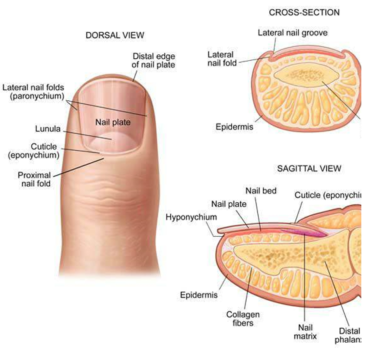Nail bed Repair
What is a nail bed injury?
The nail bed is the tissue that sits underneath the fingernail that helps the nail to grow normally. Injury is common and occurs when the digits get crushed between heavy objects. If injured, you may get a loose nail and/or blood/bruising beneath the fingernail.

What is a nail bed repair?
This is a short operation to repair the nail bed. It involves numbing the whole finger and removing the nail to provide access to the nail bed followed by repair with dissolvable stitches. In adults this can be done under local anaesthetic but young children will typically require a general anaesthetic.
What are the benefits of a repair?
Nail bed injuries can result in the nail growing abnormally, so it is important to seek medical treatment. The repair helps to:
- Reduce pain
- Speed up the nail’s healing time
- Reduce infection risk
- Reduce the risk of nail deformity
What are the risks of the procedure?
All operations carry a small risk of bleeding, infection and pain following the procedure. Other uncommon risks include:
- Abnormal or absent nail growth
- Finger stiffness
- Cold intolerance in the affected finger
- Complex regional pain syndrome
What happens after the procedure?
- You will be able to go home on the day of the operation.
- You may experience some pain and swelling: make sure to keep the hand elevated as much as possible to reduce this.
- Take regular painkillers such as paracetamol and ibuprofen for 1-2 days.
- The dressing put on after the procedure should stay on until you are seen in the dressings clinic after about one week.
- When washing or showering, keep the dressing dry by taping a plastic bag around the wrist.
- You may notice a small quantity of blood through the dressing – this is nothing to worry about. Seek medical attention if the dressing becomes soaked with blood.
- If you have been given antibiotics, be sure to finish the course. If you notice increasing pain, swelling or a smelly fluid, seek urgent medical advice.
- Avoid contact sports and activities involving sand/grit for two weeks.
- It typically takes a long time for the nail to recover: expect a new but abnormal nail by 3 months. Return of a normal nail can take around 9 months.
Exercises and aftercare
We advise the following exercises to prevent stiffness in your fingers:

- In addition, touch the tips of each finger with your thumb and then move your wrist forwards and backwards.
- Try to do these exercises as often as possible.
- After a couple of weeks, if the dressing nurse is satisfied with the healing, most patients no longer need a dressing and can get the finger wet
Follow up
- You will be reviewed in the Plastics Dressing Clinic (or paediatric dressings clinic/ paediatric hand trauma clinic) 1-2 weeks following the procedure (1st floor, Lift Bank D)
Contact information
Chelsea and Westminster Hospital
Hand Management Unit
1st Floor, Lift Bank D
T: 020 3315 2788 (Adult plastics dressing clinic)
T: 07875 284 396 (Hand Trauma Coordinator)
E: chelwest.pdc@nhs.net (adult)

